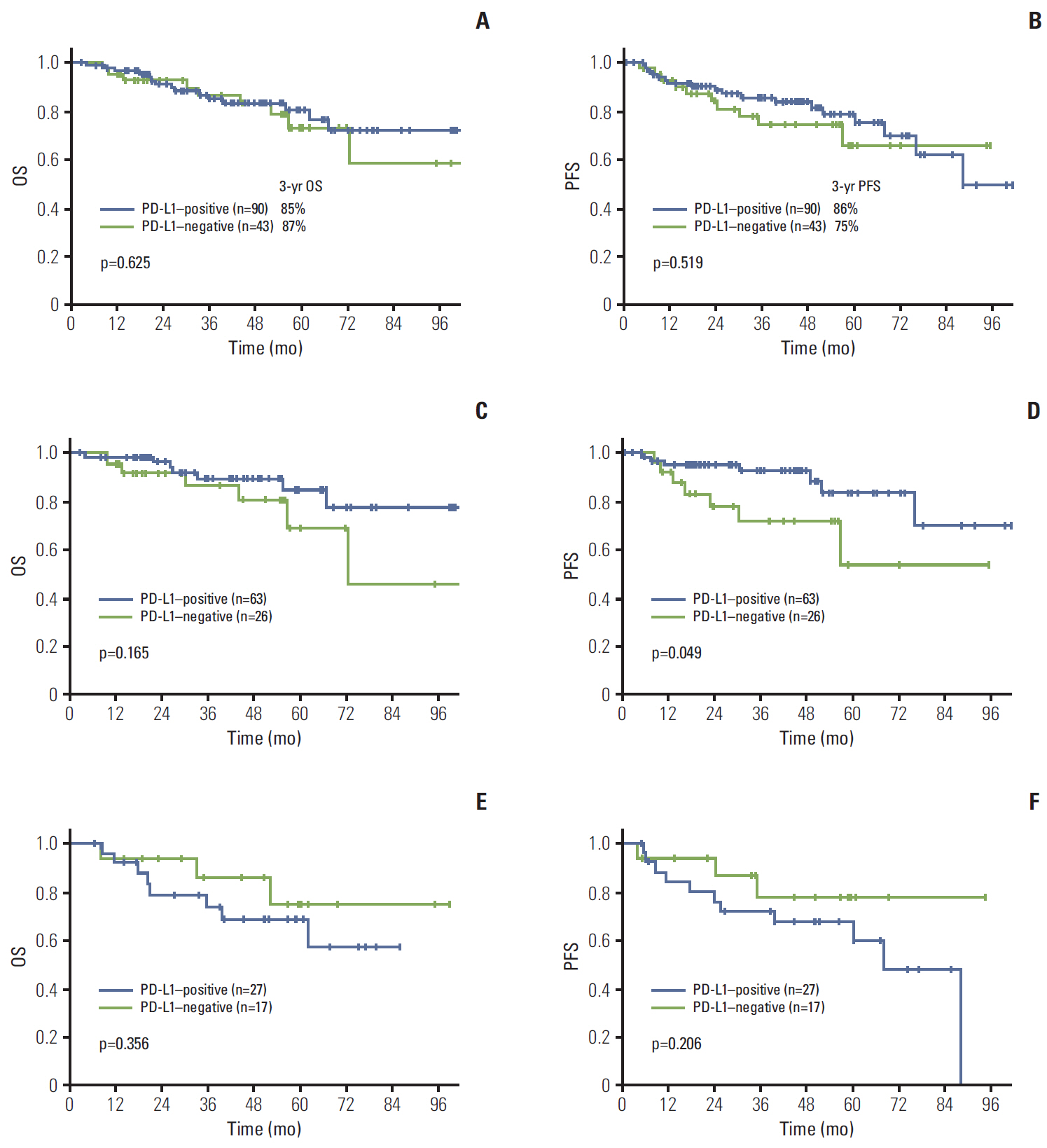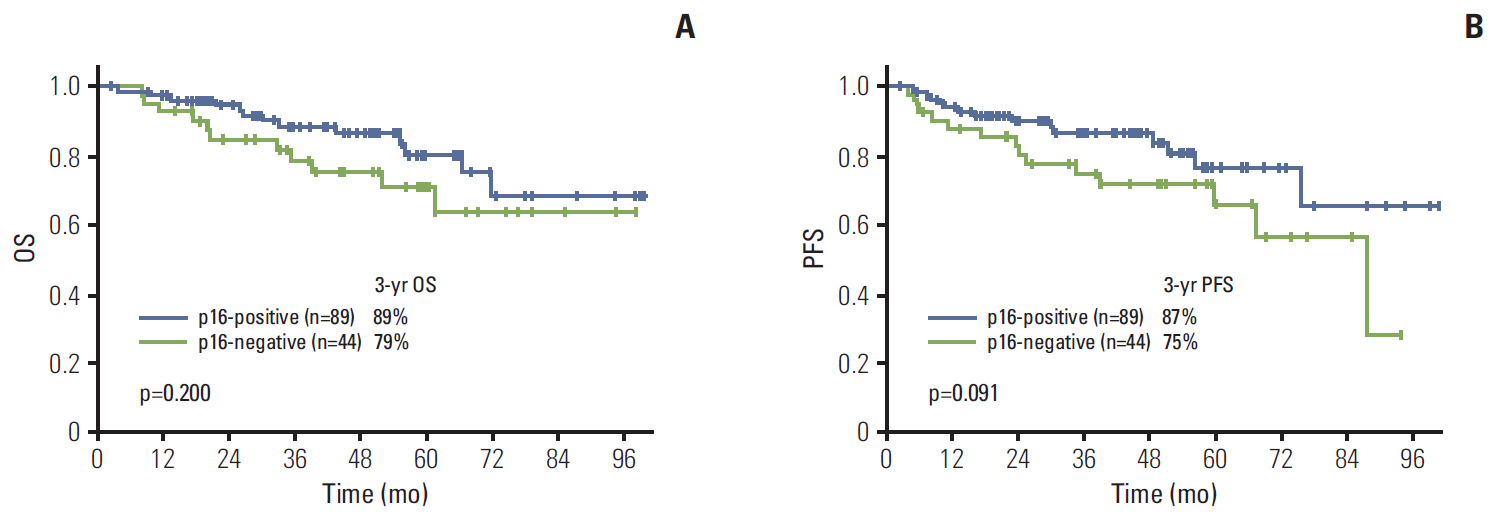Cancer Res Treat.
2016 Apr;48(2):527-536. 10.4143/crt.2015.249.
Association Between PD-L1 and HPV Status and the Prognostic Value of PD-L1 in Oropharyngeal Squamous Cell Carcinoma
- Affiliations
-
- 1Division of Hematology-Oncology, Department of Medicine, Samsung Medical Center, Sungkyunkwan University School of Medicine, Seoul, Korea. silkahn@skku.edu
- 2Department of Pathology, Samsung Medical Center, Sungkyunkwan University School of Medicine, Seoul, Korea.
- 3Department of Otorhinolaryngology-Head and Neck Surgery, Samsung Medical Center, Sungkyunkwan University School of Medicine, Seoul, Korea.
- 4Department of Radiation Oncology, Samsung Medical Center, Sungkyunkwan University School of Medicine, Seoul, Korea.
- 5Division of Hematology-Oncology, Department of Internal Medicine, Soonchunhyang University Hospital, Soonchunhyang University College of Medicine, Seoul, Korea.
- 6Department of Pathology, Kangnam Sacred Heart Hospital, Hallym University College of Medicine, Seoul, Korea.
- KMID: 2454329
- DOI: http://doi.org/10.4143/crt.2015.249
Abstract
- PURPOSE
Oropharyngeal squamous cell carcinoma (OSCC) has been recognized as an immunosuppressive disease. Various mechanisms have been proposed for immune escape, including dysregulation of immune checkpoints such as the PD-1:PD-L1 pathway. We investigated the expression of programmed cell death-ligand 1 (PD-L1) in HPV-negative and HPV-positive OSCC to determine its prevalence and prognostic relevance.
MATERIALS AND METHODS
Using immunohistochemistry, 133 cases of OSCC were evaluated for expression of PD-L1. Formalin-fixed paraffin-embedded tumor samples were stained with monoclonal antibody (clone 5H1) to PD-L1. PD-L1 positivity was defined as membrane staining in ≥20% of tumor cells. Correlations between PD-L1 expression and HPV status and survival parameters were analyzed.
RESULTS
Of the 133 patients, 68% showed PD-L1 expression, and 67% of patients were positive for p16 expression by immunohistochemistry. No significant difference in PD-L1 expression was observed between HPV(-) and HPV(+) tumors (61% vs. 71%, p=0.274). No significant difference in age, gender, smoking history, location of tumor origin, or stage was observed according to PD-L1 status. With a median follow-up period of 44 months, older age (≥65) (p=0.017) and T3-4 stage (p<0.001) were associated with poor overall survival (OS), whereas PD-L1 expression did not affect OS in univariate and multivariate analysis.
CONCLUSION
PD-L1 expression was observed in the majority of OSCC patients regardless of HPV status. Further large prospective studies are required to determine the role of PD-L1 expression as a prognostic or predictive biomarker, and clinical studies of immune checkpoint inhibitors in OCSS are warranted regardless of HPV status.
Keyword
MeSH Terms
Figure
Cited by 2 articles
-
Prevalence of high-risk human papillomavirus and its genotype distribution in head and neck squamous cell carcinomas
Yuil Kim, Young-Hoon Joo, Min-Sik Kim, Youn Soo Lee
J Pathol Transl Med. 2020;54(5):411-418. doi: 10.4132/jptm.2020.06.22.Prognostic Value of Combined Programmed Cell Death 1 Ligand and p16 Expression Predicting Responsiveness to Radiotherapy in Patients with Oropharyngeal Squamous Cell Carcinoma
Minsu Kwon, Dae Hwan Kim, Ki Ju Cho, Youngchul Kim, Jin Pyeong Kim, Bae Kwon Jeong, Jong Sil Lee, Ji-Hyun Seo, Jung Je Park
Korean J Otorhinolaryngol-Head Neck Surg. 2019;62(12):712-719. doi: 10.3342/kjorl-hns.2019.00619.
Reference
-
References
1. Gillison ML, Koch WM, Capone RB, Spafford M, Westra WH, Wu L, et al. Evidence for a causal association between human papillomavirus and a subset of head and neck cancers. J Natl Cancer Inst. 2000; 92:709–20.
Article2. Marur S, D'Souza G, Westra WH, Forastiere AA. HPV-associated head and neck cancer: a virus-related cancer epidemic. Lancet Oncol. 2010; 11:781–9.
Article3. Richards L. Human papillomavirus: a powerful predictor of survival in patients with oropharyngeal cancer. Nat Rev Clin Oncol. 2010; 7:481.4. Kreimer AR, Clifford GM, Boyle P, Franceschi S. Human papillomavirus types in head and neck squamous cell carcinomas worldwide: a systematic review. Cancer Epidemiol Biomarkers Prev. 2005; 14:467–75.
Article5. Wiest T, Schwarz E, Enders C, Flechtenmacher C, Bosch FX. Involvement of intact HPV16 E6/E7 gene expression in head and neck cancers with unaltered p53 status and perturbed pRb cell cycle control. Oncogene. 2002; 21:1510–7.
Article6. Bauman JE, Ferris RL. Integrating novel therapeutic monoclonal antibodies into the management of head and neck cancer. Cancer. 2014; 120:624–32.
Article7. Flies DB, Sandler BJ, Sznol M, Chen L. Blockade of the B7-H1/PD-1 pathway for cancer immunotherapy. Yale J Biol Med. 2011; 84:409–21.8. Robert C, Schachter J, Long GV, Arance A, Grob JJ, Mortier L, et al. Pembrolizumab versus ipilimumab in advanced melanoma. N Engl J Med. 2015; 372:2521–32.
Article9. Garon EB, Rizvi NA, Hui R, Leighl N, Balmanoukian AS, Eder JP, et al. Pembrolizumab for the treatment of non-small-cell lung cancer. N Engl J Med. 2015; 372:2018–28.
Article10. Seiwert TY, Burtness B, Weiss J, Gluck I, Eder JP, Pai SI, et al. A phase Ib study of MK-3475 in patients with human papillomavirus (HPV)-associated and non-HPV–associated head and neck (H/N) cancer. J Clin Oncol. 2014; 32 Suppl:Abstr 6011.
Article11. Badoual C, Hans S, Merillon N, Van Ryswick C, Ravel P, Benhamouda N, et al. PD-1-expressing tumor-infiltrating T cells are a favorable prognostic biomarker in HPV-associated head and neck cancer. Cancer Res. 2013; 73:128–38.
Article12. Lyford-Pike S, Peng S, Young GD, Taube JM, Westra WH, Akpeng B, et al. Evidence for a role of the PD-1:PD-L1 pathway in immune resistance of HPV-associated head and neck squamous cell carcinoma. Cancer Res. 2013; 73:1733–41.
Article13. Shi W, Kato H, Perez-Ordonez B, Pintilie M, Huang S, Hui A, et al. Comparative prognostic value of HPV16 E6 mRNA compared with in situ hybridization for human oropharyngeal squamous carcinoma. J Clin Oncol. 2009; 27:6213–21.
Article14. Begum S, Gillison ML, Ansari-Lari MA, Shah K, Westra WH. Detection of human papillomavirus in cervical lymph nodes: a highly effective strategy for localizing site of tumor origin. Clin Cancer Res. 2003; 9:6469–75.15. Dong H, Zhu G, Tamada K, Flies DB, van Deursen JM, Chen L. B7-H1 determines accumulation and deletion of intrahepatic CD8(+) T lymphocytes. Immunity. 2004; 20:327–36.
Article16. Gildener-Leapman N, Ferris RL, Bauman JE. Promising systemic immunotherapies in head and neck squamous cell carcinoma. Oral Oncol. 2013; 49:1089–96.
Article17. Ukpo OC, Thorstad WL, Lewis JS Jr. B7-H1 expression model for immune evasion in human papillomavirus-related oropharyngeal squamous cell carcinoma. Head Neck Pathol. 2013; 7:113–21.
Article18. Cho YA, Yoon HJ, Lee JI, Hong SP, Hong SD. Relationship between the expressions of PD-L1 and tumor-infiltrating lymphocytes in oral squamous cell carcinoma. Oral Oncol. 2011; 47:1148–53.
Article19. Zhang F, Liu Z, Cui Y, Wang G, Cao P. The clinical significance of the expression of costimulatory molecule PD-L1 in nasopharyngeal carcinoma. Lin Chung Er Bi Yan Hou Tou Jing Wai Ke Za Zhi. 2008; 22:408–10.20. Hsu MC, Hsiao JR, Chang KC, Wu YH, Su IJ, Jin YT, et al. Increase of programmed death-1-expressing intratumoral CD8 T cells predicts a poor prognosis for nasopharyngeal carcinoma. Mod Pathol. 2010; 23:1393–403.
Article21. Dong H, Strome SE, Salomao DR, Tamura H, Hirano F, Flies DB, et al. Tumor-associated B7-H1 promotes T-cell apoptosis: a potential mechanism of immune evasion. Nat Med. 2002; 8:793–800.
Article22. Kakavand H, Wilmott JS, Menzies AM, Vilain R, Haydu LE, Yearley JH, et al. PD-L1 expression and tumor-infiltrating lymphocytes define different subsets of MAPK inhibitor-treated melanoma patients. Clin Cancer Res. 2015; 21:3140–8.
Article23. Bhandari M, Siva S. Re: Radical nephrectomy for pT1a renal masses may be associated with decreased overall survival compared with partial nephrectomy R. H. Thompson, S. A. Boorjian, C. M. Lohse, B. C. Leibovich, E. D. Kwon, J. C. Cheville and M. L. Blute J Urol 2008; 179: 468-473. J Urol. 2008; 180:1568–9.24. Bellmunt J, Mullane SA, Werner L, Fay AP, Callea M, Leow JJ, et al. Association of PD-L1 expression on tumor-infiltrating mononuclear cells and overall survival in patients with urothelial carcinoma. Ann Oncol. 2015; 26:812–7.
Article25. Westra WH. The changing face of head and neck cancer in the 21st century: the impact of HPV on the epidemiology and pathology of oral cancer. Head Neck Pathol. 2009; 3:78–81.
Article
- Full Text Links
- Actions
-
Cited
- CITED
-
- Close
- Share
- Similar articles
-
- Immunohistochemical Expression of PD-L1 in Cutaneous Squamous Cell Carcinoma and Its Association with Risk of Metastasis
- PD-L1 as a Biomarker in Gastric Cancer Immunotherapy
- Prognostic Value of Combined Programmed Cell Death 1 Ligand and p16 Expression Predicting Responsiveness to Radiotherapy in Patients with Oropharyngeal Squamous Cell Carcinoma
- Prevalence and prognostic value of PD-L1 expression and tumor mutational burden in persistent, recurrent, or metastatic cervical cancer
- Evaluation of circulating PD-1 and PD-L1 as diagnostic biomarkers in dogs with tumors



